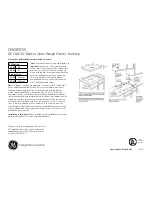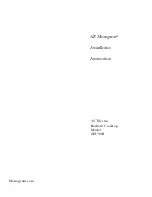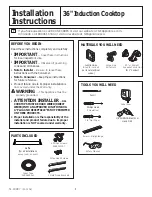
Rigid Connections:
• Incoming gas is brought from an intake
pipe (not supplied) at the rear of the unit
to the pressure regulator; then to the
manifold pipe for distribution. The only
connection necessary is from the service
supply, through the shut-off valve (not
supplied), to this intake pipe (not
supplied) to the regulator supplied, but
not connected through the cooktop.
In Massachusetts:
This appliance must be
installed with a 36” (3-foot) long flexible gas
connector.
LP/Propane Conversion
The VGSU models are field convertible to
LP/Propane gas or natural gas. The orifice
spuds and regulator must be physically
changed. For the VGSU models, order
conversion kit NKPDC to convert to natural
and LPKPDC to convert to LP/Propane. Gas
conversions should be completed by a
qualified technician. Refer to instructions in
conversion kit for gas conversions.
13
Before placing the cooktop into operation,
always check for gas leaks with a soapy
water solution or other acceptable method.
DO NOT
USE AN OPEN FLAME TO
CHECK FOR LEAKS.
CAUTION
Electrical & Gas Requirements
Initial Ignition of Burners
All cooktops are tested before leaving the
factory. Field adjustments may be necessary
for proper mixture of gas and air for proper
operation. When the cooktop is connected
to gas and electrical service, it should be
adjusted by a qualified technician. If it is not,
contact your dealer for the name of their
authorized service agency in your area.
Gas conversions and initial installation
adjustments are not the responsibility of the
manufacturer. To convert the VGSU model
to LP or natural gas, the orifice spuds and
regulator must be physically changed. The
proper conversion kit must be ordered from
your authorized service agency or dealer.
Proper Lighting and Shutdown
Instructions
1. To ignite the surface burners, turn the
knob counter clockwise to any position.
2. Upon ignition of the surface burner, turn
the knob to the desired position, (HI,
Med, or Low).
3. To shutdown the burner, turn knob
clockwise to the OFF position.
4. In case of failure, shut the gas OFF using
the installer supplied manual shut-off
valve.
Electrical & Gas Requirements
Electrical Requirements
There is no connection necessary beyond
plugging the unit into a polarized,
grounded, 120 volt, 60 Hz, 15 amp circuit. A
minimum of 120VAC is required for proper
operation of gas ignition systems.
DO NOT
use a GFI circuit. This circuit, however,
MUST
be grounded and properly polarized. The
unit is equipped with 16-3 SPT2 power cord.
Note:
If electrical power is not supplied or is
interrupted, the open top burners will have
to be lit manually with a match.
Gas Connection
The gas supply (service) line must be the
same size or greater than the inlet line of the
appliance. All cooktops use a 1/2” (1.3 cm)
I.D. NPT (Sch40) inlet. Sealant on all pipe
joints must be resistive to LP/Propane gas.
These cooktops are designed specifically for
natural gas or liquid propane (LP) gas. It is
shipped from the factory adjusted for use
with natural or propane (LP) gas. Before
beginning installation verify that the model is
compatible with the intended gas supply.
IMPORTANT: Any conversion required
must be performed by a qualified licensed
plumber or gas service company. The
proper conversion kit must be ordered
from your authorized service agency or
dealer.
Manual shut-off valve:
• The installer-supplied valve must be
installed in the gas service line ahead of
the appliance and regulator in the gas
stream and in a position where it can be
reached quickly in the event of an
emergency.
In Massachusetts:
A “T” handle type
manual gas valve must be installed in
gas supply line to the appliance.
Pressure regulator:
• All heavy-duty, commercial-type cooking
equipment must have a pressure regulator
on the incoming service line for safe and
efficient operation, since service pressure
may fluctuate with local demand. The
regulator supplied with the cooktops must
be installed before any gas connections
are made.
• Manifold pressure should be checked with
a manometer; natural gas requires 5.0”
WCP and LP/Propane requires 10.0” WCP.
Incoming line pressure upstream for the
regulator must be 1” WCP higher than the
manifold pressure in order to check the
regulator. The regulator used on this
cooktop can withstand a maximum input
pressure of 1/2 PSI (14.0” WCP).
If
the line pressure is in excess of that
amount, a stepdown regulator will be
required.
• The appliance must be disconnected from
the gas supply piping system during any
pressure testing of that system.
12




























